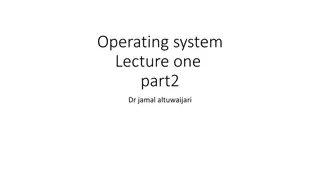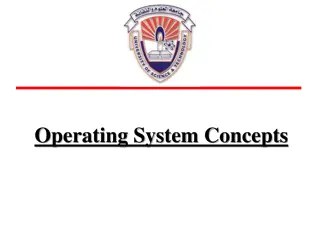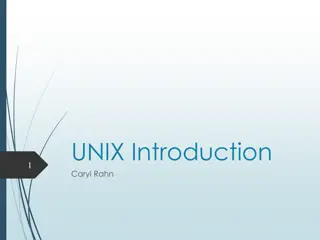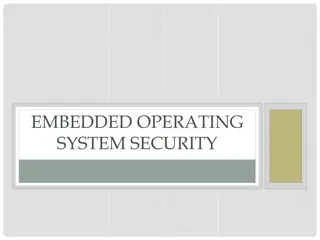Evolution of Operating Systems: A Historical Journey
Explore the fascinating evolution of operating systems from the late 1950s to the 1970s, including key milestones such as the development of Unix, DOS, and Windows. Discover how operating systems have progressed to support multi-tasking and multi-user capabilities, dynamic address translation, and modular architectures.
Download Presentation

Please find below an Image/Link to download the presentation.
The content on the website is provided AS IS for your information and personal use only. It may not be sold, licensed, or shared on other websites without obtaining consent from the author.If you encounter any issues during the download, it is possible that the publisher has removed the file from their server.
You are allowed to download the files provided on this website for personal or commercial use, subject to the condition that they are used lawfully. All files are the property of their respective owners.
The content on the website is provided AS IS for your information and personal use only. It may not be sold, licensed, or shared on other websites without obtaining consent from the author.
E N D
Presentation Transcript
History Of OS Operating systems were first developed in the late 1950s to manage tape storage The General Motors Research Lab implemented the first OS in the early 1950s for their IBM 701 In the mid-1960s, operating systems started to use disks In the late 1960s, the first version of the Unix OS was developed The first OS built by Microsoft was DOS. It was built in 1981 by purchasing the 86-DOS software from a Seattle company The present-day popular OS Windows first came to existence in 1985 when a GUI was created and paired with MS-DOS. 2
Evolution of Operating Systems The evolution of operating systems is directly dependent on the development of computer systems and how users use them. Here is a quick tour of computing systems through the past fifty years in the timeline. Early Evolution 1945: ENIAC, Moore School of Engineering, University of Pennsylvania. 1949: EDSAC and EDVAC 1949: BINAC - a successor to the ENIAC 1951: UNIVAC by Remington 1952: IBM 701 1956: The interrupt 1954-1957: FORTRAN was developed 3
Evolution of Operating Systems Operating Systems - Late 1950s By the late 1950s Operating systems were well improved and started supporting following usages: It was able to perform Single stream batch processing. It could use Common, standardized, input/output routines for device access. Program transition capabilities to reduce the overhead of starting a new job was added. Error recovery to clean up after a job terminated abnormally was added. Job control languages that allowed users to specify the job definition and resource requirements were made possible. 4
Evolution of Operating Systems Operating Systems - In 1960s 1961: The dawn of minicomputers 1962: Compatible Time-Sharing System (CTSS) from MIT 1963: Burroughs Master Control Program (MCP) for the B5000 system 1964: IBM System/360 1960s: Disks became mainstream 1966: Minicomputers got cheaper, more powerful, and really useful. 1967-1968: Mouse was invented. 1964 and onward: Multics 1969: The UNIX Time-Sharing System from Bell Telephone Laboratories. 5
Evolution of Operating Systems Supported OS Features by 1970s Multi User and Multi tasking was introduced. Dynamic address translation hardware and Virtual machines came into picture. Modular architectures came into existence. Personal, interactive systems came into existence. 6
Evolution of Operating Systems Accomplishments after 1970 1971: Intel announces the microprocessor 1972: IBM comes out with VM: the Virtual Machine Operating System 1973: UNIX 4th Edition is published 1973: Ethernet 1974 The Personal Computer Age begins 1974: Gates and Allen wrote BASIC for the Altair 1976: Apple II 7
Evolution of Operating Systems August 12, 1981: IBM introduces the IBM PC 1983 Microsoft begins work on MS-Windows 1984 Apple Macintosh comes out 1990 Microsoft Windows 3.0 comes out 1991 GNU/Linux 1992 The first Windows virus comes out 1993 Windows NT 2007: iOS 2008: Android OS 8
Features of Operating System Here is a list commonly found important features of an Operating System: Protected and supervisor mode Allows disk access and file systems Device drivers Networking Security Program Execution Memory management Virtual Memory Multitasking Handling I/O operations Manipulation of the file system Error Detection and handling Resource allocation Information and Resource Protection 9
Types of Operating System Batch Operating System. Multitasking/Time Sharing OS. Multiprocessing OS. Real Time OS. Distributed OS. Network OS. Mobile OS. 10
Batch Operating System Some computer processes are very lengthy and time-consuming. To speed the same process, a job with a similar type of needs are batched together and run as a group. The user of a batch operating system never directly interacts with the computer. In this type of OS, every user prepares his or her job on an offline device like a punch card and submit it to the computer operator. 11
Batch Operating System To speed up processing, jobs with similar needs are batched together and run as a group. The programmers leave their programs with the operator and the operator then sorts the programs with similar requirements into batches. The problems with Batch Systems are as follows Lack of interaction between the user and the job. CPU is often idle, because the speed of the mechanical I/O devices is slower than the CPU. Difficult to provide the desired priority. 12
Multi-Tasking/Time-sharing OS Time-sharing operating system enables people located at a different terminal(shell) to use a single computer system at the same time. The processor time (CPU) which is shared among multiple users is termed as time sharing. Time-sharing is a technique which enables many people, located at various terminals, to use a particular computer system at the same time. Time-sharing or multitasking is a logical extension of multiprogramming. Processor's time which is shared among multiple users simultaneously is termed as time- sharing. The main difference between Multiprogrammed Batch Systems and Time-Sharing Systems is that in case of Multiprogrammed batch systems, the objective is to maximize processor use, whereas in Time-Sharing Systems, the objective is to minimize response time. 13
Multi-Tasking/Time-sharing OS Multiple jobs are executed by the CPU by switching between them, but the switches occur so frequently. Thus, the user can receive an immediate response. For example, in a transaction processing, the processor executes each user program in a short burst or quantum of computation. That is, if n users are present, then each user can get a time quantum. When the user submits the command, the response time is in few seconds at most. The operating system uses CPU scheduling and multiprogramming to provide each user with a small portion of a time. Computer systems that were designed primarily as batch systems have been modified to time-sharing systems. Advantages of Timesharing operating systems are as follows Provides the advantage of quick response. Avoids duplication of software. Reduces CPU idle time. Disadvantages of Time-sharing operating systems are as follows Problem of reliability. Question of security and integrity of user programs and data. Problem of data communication. 14
Real time OS A real time operating system time interval to process and respond to inputs is very small A real-time system is defined as a data processing system in which the time interval required to process and respond to inputs is so small that it controls the environment. The time taken by the system to respond to an input and display of required updated information is termed as the response time. So in this method, the response time is very less as compared to online processing. 15
Real time OS Real-time systems are used when there are rigid time requirements on the operation of a processor or the flow of data and real-time systems can be used as a control device in a dedicated application. A real-time operating system must have well-defined, fixed time constraints, otherwise the system will fail. For example : Military Software Systems, Space Software Systems. Scientific experiments, medical imaging systems, industrial control systems, weapon systems, robots, air traffic control systems, etc. 16
Real time OS There are two types of real-time operating systems. Hard real-time systems Hard real-time systems guarantee that critical tasks complete on time. In hard real-time systems, secondary storage is limited or missing and the data is stored in ROM. In these systems, virtual memory is almost never found. Soft real-time systems Soft real-time systems are less restrictive. A critical real-time task gets priority over other tasks and retains the priority until it completes. Soft real-time systems have limited utility than hard real-time systems. For example, multimedia, virtual reality, Advanced Scientific Projects like undersea exploration and planetary rovers, etc. 17
Distributed Operating System Distributed systems use many processors located in different machines to provide very fast computation to its users. Distributed systems use multiple central processors to serve multiple real-time applications and multiple users. Data processing jobs are distributed among the processors accordingly. The processors communicate with one another through various communication lines (such as high-speed buses or telephone lines). These are referred as loosely coupled systems or distributed systems. Processors in a distributed system may vary in size and function. These processors are referred as sites, nodes, computers, and so on. 18
Distributed Operating System The advantages of distributed systems are as follows With resource sharing facility, a user at one site may be able to use the resources available at another. Speedup the exchange of data with one another via electronic mail. If one site fails in a distributed system, the remaining sites can potentially continue operating. Better service to the customers. Reduction of the load on the host computer. Reduction of delays in data processing. 19
Network Operating System A Network Operating System runs on a server. It provides the capability to serve, to manage data, user, groups, security, application, and other networking functions. The primary purpose of the network operating system is to allow shared file and printer access among multiple computers in a network, typically a local area network (LAN), a private network or to other networks. 20
Network Operating System Examples of network operating systems include Microsoft Windows Server 2003, Microsoft Windows Server 2008, UNIX, Linux, Mac OS X, Novell NetWare, and BSD. The advantages of network operating systems are as follows Centralized servers are highly stable. Security is server managed. Upgrades to new technologies and hardware can be easily integrated into the system. Remote access to servers is possible from different locations and types of systems. The disadvantages of network operating systems are as follows High cost of buying and running a server. Dependency on a central location for most operations. Regular maintenance and updates are required. 21
Mobile OS Mobile operating systems are those OS which is especially that are designed to power smartphones, tablets, and wearables devices- Smart watch , smart glasses. Some most famous mobile operating systems are Android and iOS, but others include BlackBerry, Web, and watchOS. 22
Difference between Firmware and Operating System Firmware Operating System Firmware programming that is embedded on a chip in the device which controls that specific device. is one kind of OS provides functionality over and above that provided by the firmware. which is Firmware programs that been encoded by the manufacture of the IC or something and cannot be changed. OS is a program that can be installed by the user and can be changed. It is stored on non-volatile memory. OS is stored on the hard drive. 23
Important functions of an OS Memory Management Processor Management Device Management File Management Security Control over system performance Job accounting Error detecting aids Coordination between other software and users 24
Memory Management Memory management refers to management of Primary Memory or Main Memory. Main memory is a large array of words or bytes where each word or byte has its own address. Main memory provides a fast storage that can be accessed directly by the CPU. For a program to be executed, it must in the main memory. An Operating System does the following activities for memory management: Keeps tracks of primary memory, i.e., what part of it are in use by whom, what part are not in use. In multiprogramming, the OS decides which process will get memory when and how much. Allocates the memory when a process requests it to do so. De-allocates the memory when a process no longer needs it or has been terminated. 25
Processor Management In multiprogramming environment, the OS decides which process gets the processor when and for how much time. This function is called process scheduling. An Operating System does the following activities for processor management: Keeps tracks of processor and status of process. The program responsible for this task is known as traffic controller. Allocates the processor (CPU) to a process. De-allocates processor when a process is no longer required. 26
Device Management An communication via their respective drivers. It does the following management: Keeps tracks of all devices. The program responsible for this task is known as the I/O controller. Decides which process gets the device when and for how much time. Allocates the device in the most efficient way. De-allocates devices. Operating System manages device activities for device 27
File Management A file system is normally organized into directories for easy navigation and usage. These directories may contain files and other directions. An Operating System does the following activities for file management: Keeps track of information, location, uses, status etc. The collective facilities are often known as file system. Decides who gets the resources. Allocates the resources. De-allocates the resources. 28
Other Important Activities Following are some of the important activities that an Operating System performs: Security -- By means of password and similar other techniques, it prevents unauthorized access to programs and data. Control over system performance -- Recording delays between request for a service and response from the system. Job accounting -- Keeping track of time and resources used by various jobs and users. 29
Other Important Activities Error detecting aids -- Production of dumps, traces, error messages, and other debugging and error detecting aids. Coordination between other software and users -- Coordination and assignment of compilers, interpreters, assemblers and other software to the various users of the computer systems. 30
Operating System Different View Points Process View point Extended Machine View Hierarchical Machine View
Process View point Multiple Processes in a multiprogrammes system Process 1 Process 2 Process 3 Operating Systems
Process View point Submit A User submits a Job to the system, the system must respond to the user s request. Hold/New The user s job has been converted into internal machine readable form ,i.e., a process is generated. Ready Multiple processes are ready to run under a CPU. Run The process has been assigned a processor and its programs are presently being executed. Wait The process is waiting for some event (I/O). Complete/Termination The process has completed its computation and all its assigned and all its resources may be reclaimed.
Extended Machine View Bare Machine a computer without its software clothing. Eg. program 1. MOVE C,B 2. FIND-SPACE 80,X 3. READ-CARD X 4. COMPARE X(2), /* 5. TRANSFER-MATCH END
Extended Machine View Statements 1,4,5 are computer instructions. Statements 2 and 3 are required tens, hundreds or even thousands of instructions to be correctly and efficiently accomplished on a modern computer they involve interaction with some of the key system resources, such as memory and I/O. The instructions to perform these kinds of resource management functions are usually provided by the OS. The sum of these instructions is called the instruction set of the extended machine
Extended Machine View Process 1 Process 3 Extended Machine Bare Machi ne Process 2 Process 4
Hierarchical Machine View 1. Key functions needed by many systems modules could be separated into an inner extended machine 2. Certain modules could be separated out and run on the extended machine in essentially the same way as user processes.
Hierarchical Machine View Outer extended machine Process 1 Process 3 Inner extended machine BareMachine n Bare machine Process 4 Process 2
Hierarchical Machine View Primitive functions in the various levels of the kernel are Level 1 : Processor Management Lower level The P synchronization primitive The V synchronization primitive Process scheduling the mechanism of multiprogramming Level 2 : Memory Management Allocate memory Release (free) memory
Hierarchical Machine View Level 3 : Processor Management Upper level Create/destroy process Send/receive messages between processes Stop process Start process Level 4 : Device Management Keep track of status of all I/O devices Schedule I/O Initiate I/O process Level 5 : Information Management Create/destroy file Open/close file Read/write files
I/O Programming I/O programming Types of I/O channels I/O programming concepts I/O process structure Communication between the CPU and the channel I/O Example using Single buffering I/O Example using Double buffering Multiple card buffering
I/O Programming Memory Processor Card Reader Card Reader Printer Mag tape Mag tape
I/O Programming Three basic components the CPU, main memory, I/O devices. Speed disparity between CPU and I/O devices motivated the development of I/O channel I/O channels are directly connected to the memory the I/O devices connected to the I/O channel
I/O channels I/O Channel definition: I/O channels or I/O processors provide a path or channel for the data to flow between I/O devices and main memory. Specialized processing units intended to operate the I/O devices. I/O operations are executed via the channel, the CPU is free to perform its high speed computations without wasting time for I/O.
Types of I/O channels Selector Channel Multiplexor Channel Block Multiplexor Channel Selector Channel : can service only one device at a time, i.e., one device is selected for service. These channels used for very high speed devices. eg. Magnetic tapes, disks and drums, each I/O request is usually completed quickly and then another device selected for I/O.























